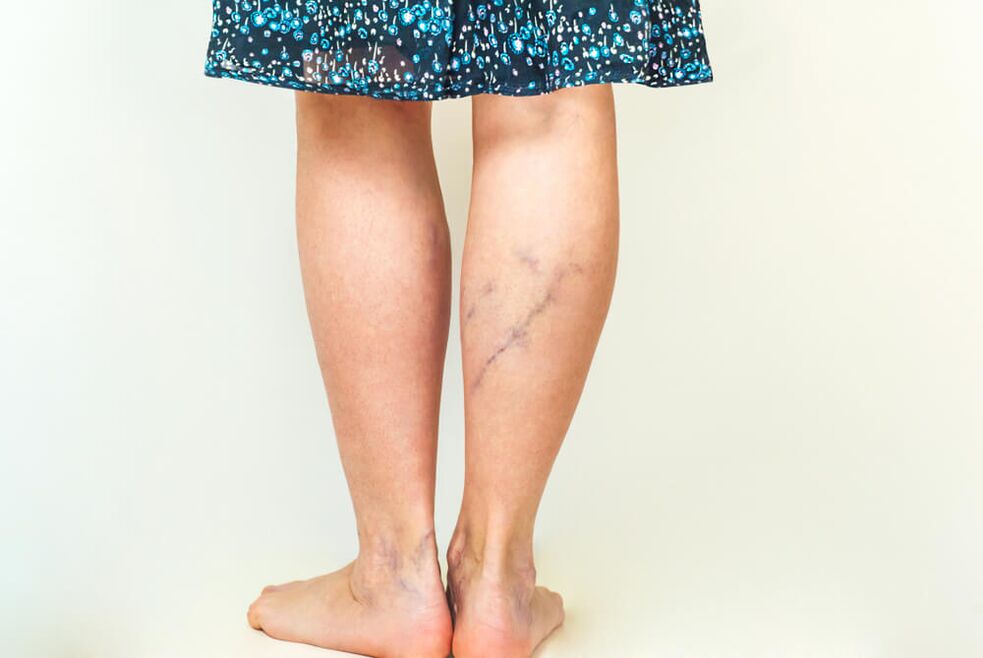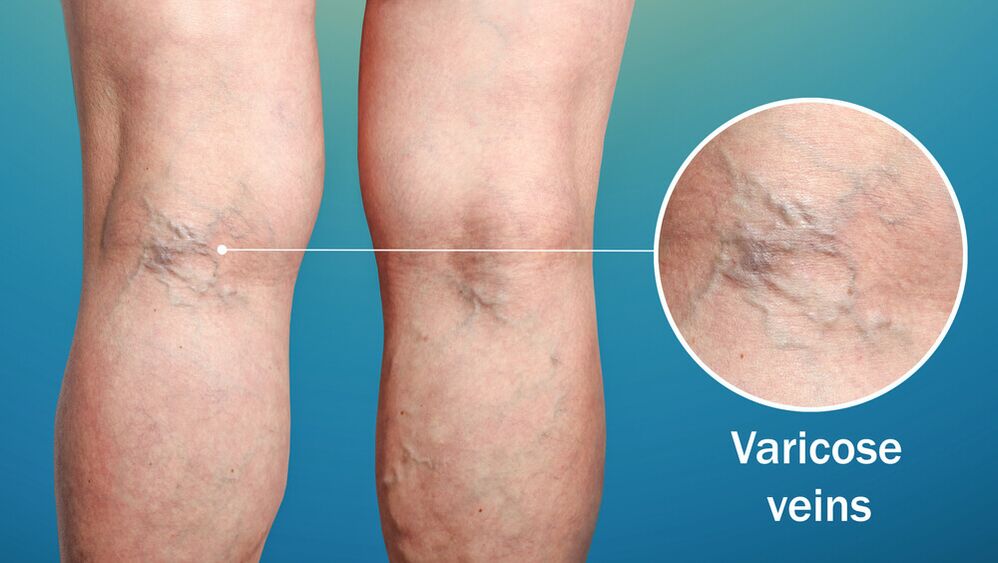Varicose veins (varicose veins) is one of the most common circulatory disorders, which is accompanied by pathological changes in the vessels of the lower extremities, the formation of nodes and trophic ulcers. Patients also suffer from cramps and swelling, which worsen with physical activity. Varicose veins in the legs are more common in women than in men. This is due to physiological characteristics.
The disease requires the help of specialists and a well-organized fight, since treating varicose veins on the legs without the help of specialists, especially when deep veins are affected, is risky. If treatment procedures are ineffective, the risk of developing thrombophlebitis and other life-threatening complications increases sharply. Studying the signs of varicose veins in women and treating the disease are the responsibility of a phlebologist. It is this specialist that you should contact if you discover vascular disorders of the lower extremities.

Signs of varicose veins
At the initial stage of development of the disease, symptoms of varicose veins may be absent. A woman should be alert to any vascular changes in her legs, a tendency to evening swelling and a feeling of discomfort in her legs. If all the veins become more visible, you should also pay attention to such changes.
Varicose veins of the legs in women are accompanied by the following symptoms:
- expanded network of capillaries, spider veins on the legs;
- feeling of heaviness and fatigue in the legs;
- swelling of the limbs;
- pain in the legs, which gets worse with prolonged standing or sitting;
- muscle cramps;
- trophic ulcers.
Sometimes varicose veins of internal organs develop in women, which is not always combined with external manifestations on the legs. In such cases, the pelvic area is most often affected. The disease occurs predominantly in women of active reproductive age.
Causes of varicose veins in women
The main cause of varicose veins on the legs in women is stagnation of blood in the legs with subsequent disruption of the valvular apparatus of the veins. The disorder can be caused by hereditary weakness of the venous walls, increased stress on the limbs during pregnancy, and the use of narrow and uncomfortable shoes. A phlebologist will be able to say exactly why varicose veins in the legs develop in a particular woman after studying the medical history and the results of a comprehensive examination.
Treatment of varicose veins in women
For swollen veins in the legs of women, treatment can be conservative or surgical. Drug therapy is used at the initial stage of disease development, when the pathology is not accompanied by serious disturbances in the functioning of the valve apparatus and the risk of complications.
The treatment regimen usually includes:
- venotonics (phlebotonics);
- wearing compression stockings;
- the use of local ointments and creams that accelerate tissue healing, relieve heaviness and pain from the lower extremities, and reduce inflammation;
- physical therapy.
Therapeutic treatment necessarily includes the use of phlebotonics in the form of capsules, ointments and gels.
Local remedies relieve swelling, heaviness in the legs, and reduce swelling. In case of severe swelling, diuretics are prescribed. Antithrombotic drugs are also indicated if the risk of developing blood clots remains. The patient is contraindicated in increased physical activity, work associated with heavy lifting and long periods of standing on his feet.
If these recommendations cannot be followed and the patient cannot change the type of activity, it is necessary to regularly do exercises for the lower extremities to restore blood circulation and eliminate congestion. Shoes should be as comfortable as possible, not squeezing the top and toes.
If you have varicose veins in the early stages, be sure to use compression garments - tights, stockings. They relieve increased stress from the lower extremities and unload the lymphatic system. Compression hosiery will not make the nodes less noticeable and will not play a decisive role in the fight against the disease, but it will help prevent the development of complications and slow down the progression of the pathology. Stockings are recommended to be worn when there is increased load on the legs. Compression garments must be used after surgery to prevent blood clots.
Sclerotherapy
It is not always possible to cure varicose veins using only conservative methods, so phlebologists recommend not postponing surgery if your doctor insists on it. In most cases, the surgeon recommends surgery to remove the pathological nodes and restore normal blood circulation. If there are no contraindications, minimally invasive treatment methods are used, in particular sclerotherapy. It involves the treatment of varicose veins with the help of special sclerosant drugs by introducing into the lumen of the vessel agents that lead to the collapse of the vascular walls and the cessation of their participation in the blood circulation. The operation takes place without skin incisions. The dilated vessels of the lower extremities gradually fuse together with the help of sclerosing substances, turning into cords of connective tissue, and then resolve and disappear.
Laser coagulation
If spider veins are present and small vessels are dilated, the surgeon may also recommend laser coagulation. Laser energy causes protein coagulation. During laser coagulation, the doctor inserts a probe with a laser tip into the lumen of the damaged vein, which "seals" its walls, causing vascular spasm. Subsequently, the vessel will be replaced by connective tissue. The procedure is performed under local anesthesia, there is no pain.
Over the course of several weeks, necrotic changes occur in the walls of blood vessels, which transform the venous walls into cords of connective tissue. Blood no longer circulates through them, as they fall out of the circulation. But coagulation of the venous walls of the lower extremities does not exclude relapse of the disease. Under the influence of unfavorable external and internal factors, intact vessels can expand with the formation of reverse blood flow and nodular deformations.
During the first weeks after surgery, it is recommended to avoid physical exertion, not spend long periods of time on your feet, and wear compression stockings or tights. Additionally, anticoagulant drugs are prescribed to prevent the formation of blood clots.
Phlebectomy
Phlebectomy is an operation during which the surgeon removes varicose veins, including deep ones. During surgery, the trunk of the great saphenous vein and pathologically altered tributaries are removed. At the same time, blood circulation is not disturbed, since they account for only 10% of the blood flow. The rest of the blood circulates in the deep blood vessel system.
Phlebectomy eliminates vertical reflux, eliminates horizontal blood discharge and its pathological flow, which contributes to the progression of varicose veins even after the use of minimally invasive methods of surgical treatment. The operation is performed under general anesthesia.
Preventive actions

Varicose veins are a common circulatory disorder that can greatly impact your quality of life. To prevent this disease, it is necessary to monitor the condition of the blood vessels in the legs and maintain a correct lifestyle.
It is recommended to avoid prolonged sitting and standing in one place. Prolonged static loads cause overfilling of the veins, expansion of their walls and deformation. Constant tension leads to stagnation of blood and increased pressure in the extremities. Regular breaks from work and exercises aimed at relieving congestion in the legs will help maintain the functionality of the valve apparatus.
It is also very important to monitor your weight and eat right. Avoid fatty and salty foods, as well as smoking and drinking alcohol. These bad habits can complicate the course of varicose veins, increasing the risk of complications. Wearing compression garments will also be an excellent addition to the prevention of vein disease. Elastic compression improves blood circulation and reduces stress on the limbs.
If you need to be on your feet for a long time or use uncomfortable shoes, physical therapy is necessary. It is aimed at restoring normal blood flow in the legs and eliminating lymph stagnation. Exercise therapy is recommended to be carried out during breaks between work, after severe fatigue. Additionally, it is necessary to use venotonic agents in the form of cream, gel or ointment. Such drugs relieve discomfort, reduce swelling, and prevent the development of varicose veins at the initial stage of the disease.
























